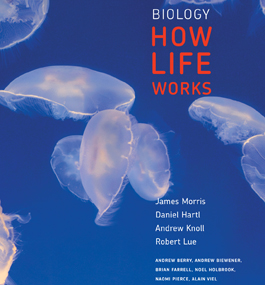Throwing the Book at Biology

W.H. Freeman & Co./Macmilllan
by Laura Gardner, P'12
As an American studies major at Georgetown University, Claudia Gilmore had plenty of experience taking exams. But at the age of 21, she faced an altogether different kind of test — and no amount of studying could have prepared her for the result. Gilmore had decided to be tested for a mutation in a gene known as BRCA1.
Intrigued by this story? Associate professor of biology Jim Morris hopes the nation’s introductory biology students will be, too.
Morris is a lead author of “Biology: How Life Works,” an inch-and-a-half-thick textbook published this year by W.H. Freeman.
Buoyed by gripping graphics and a companion website with interactive lessons and animations, the volume seems equipped to make good on its audacious subtitle. Though Gregor Mendel still gets credit for his role in discovering inherited genetic variation through his famous pea experiments, you’ll find the humble monk a couple of chapters after a dramatic introduction to genetics that features Ms. Gilmore.
Could this textbook become intro biology’s equivalent of Kittredge’s “Complete Works of Shakespeare” or Janson’s “History of Art”? That’s the goal, says Morris, who holds an MD and a PhD from Harvard, and worked with the team of Harvard-based biologists who developed the textbook and its companion website.
“We rethought all aspects of the book — the amount of content, the way it is organized and emphasized,” says Morris. It’s not a traditional reference book (that’s what Google is for); “How Life Works” is a fresh look at the interdisciplinary field biology has become.
“The point is not to cover everything, but to provide a framework for understanding key concepts and the habits of mind students need to develop in order to grow,” explains Morris.
Using case studies, the book explores cancer, biodiversity, malaria, the relationship between predator and prey, and a host of other topics. It is the only textbook available that really emphasizes evolution as a unifying principle of biology, says Morris.
“I hope this book will help maintain the enthusiasm for science students start out with,” he says. “In a democracy, everyone has to be scientifically literate.”
